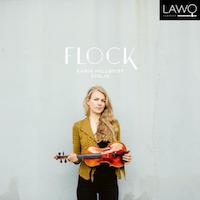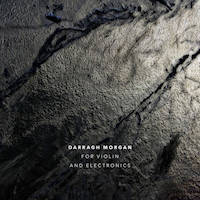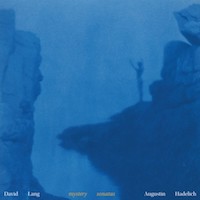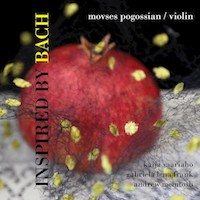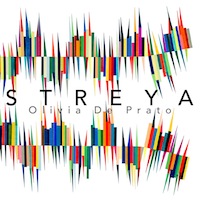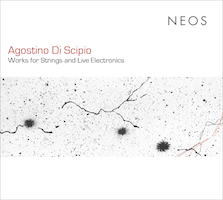String Theory 30. / EA Bucket 29: Violin, sometimes with electronics
|
Grant Chu Covell [March 2020.]
“Flock.” Carola BAUCKHOLT: Doppelbelichtung (2016). Jan Marin SMØRDAL: flock foam fume (2016). Henrik STRINDBERG: Femte strängen (2009). Malin BÅNG: …når korpen vitnar (2003). Natasha BARRETT: Sagittarius A* (2017). Karin Hellqvist (vln). Lawo Classics LWC1179 (1 CD) (http://www.lawo.no/). Doppelbelichtung (“Double Exposure”) presents the ingenious effect of birds imitating the violin. Advanced preparation enables the violinist to copy reality, but in performance the taped sounds follow. Perhaps the birdsongs have been lightly tampered with to fit within familiar scales, as the exchange of instrument and recorded warblers confounds and charms. François-Bernard Mâche’s Korwar (1972) comes to mind wherein harpsichord imitates animals and African languages. In performance, Bauckholt places speakers under the audience’s seats and within decorative violins arranged about the space. Flock foam fume surrounds the live violinist with pre-recorded versions of the same material. This time the imitation is the soloist herself, with some processing. Like Doppelbelichtung, there is graceful humor, even when the violin clones become distorted. Femte strängen begins with harmonics similar to Doppelbelichtung and proceeds as a solo etude of arpeggios and speedy string crossings. The “Fifth String” could be a higher register where the dry sound of the hair scraping the strings becomes more prominent. …når korpen vitnar is another solo piece, originally written for Hardanger fiddle. “When the Raven Black turns White” is a scaled down tone poem with 20th-century virtuosic gestures. At nearly a half-hour long, Sagittarius A* (the title’s last part is to be pronounced “a star”) includes a lively tape and realtime electronic processing (this might be a live recording). The pre-recorded sounds run the gamut (there are Varèsian organ outbursts) to create a busy and active universe, in this case, specifically referencing the energy at the center of the Milky Way.
“For Violin and Electronics.” Paul WILSON: Trapped in Ice (2007). Jonty HARRISON: Some of its Parts (2011-12). Scott WILSON: Flame (2005). Ricardo CLIMENT: Koorean Air (2010). Simon EMMERSON: Stringscape (2010). Jonathan NANGLE: Where distant city lights flicker on half-frozen ponds (2011). Darragh Morgan (vln). Diatribe DIACD021 (1 CD) (http://www.diatribe.ie/). These six pieces reflect the gamut of how an instrument can interact with tape. Some use electronics or tape as a fixed backdrop and emphasize the violin’s traditional lyricism. Trapped in Ice captures the moment when a frozen landscape changes. Perhaps we hear feeble sun warming ice or water trickling under impassive snow. Electronics extend the violin’s sound spinning fragile rays. Flame is similar, as the violin releases a single cantilevered span exploring the upper parts of the harmonic series. Coarse processing provides contrast. There is a small, recurring motive that anchors the synthesized tones as they “pass through” the live violin, and an optional interactive video component. In the longest piece, Stringscape, the violin ambles across a quilt woven from string sounds, held tones, and rapid gestures. These three pieces have their moments, but they can be hard to distinguish from one another. Visuals would reveal how Morgan reacts to the electronics and vice versa. The most energetic works in this collection are Some of its parts and Koorean Air. The tape in Some of its parts pulls sounds created from sources other than the violin, and can also be performed by any combination of violin, piano and percussion plus tape. The soloist flings agitated growls among various extended techniques, accompanied by mysterious creaking, vibrating springs and what sounds like resonant clock interiors. Koorean Air propels a boisterous interchange between Morgan and a universe created from cloned bits. Climent calls this “electronic de-hyper-instrumentalisation” which is a reasonable label for the scattering and recombination of violin sounds. I am not sure if the title references an airline or something else. Where distant city lights flicker on half-frozen ponds is a modest exploration (6:48) of a repeated phrase with electronic echoes (called “resonators”). The cycling minor mode double-stops suggest Pärt, whereas, in fact, Nangle took his title from the art critic Jonathan Jones who had been describing a set of Gerhard Richter’s paintings which were themselves a homage to Cage.
David LANG: Mystery Sonatas (2014). Augustin Hadelich (vln). Cantaloupe Music CA21142 (1 CD) (http://www.cantaloupemusic.com/). Hadelich keeps busy and sounds crystal clear throughout Lang’s seven-part garland. The title connects with Biber’s 1676 collection, also called the Rosary Sonatas, however, unlike Biber, Lang does not require scordatura and looks inwards without religious intent. The movement titles suggest contemplation: “Joy,” “After Joy,” “Before Sorrow,” “Sorrow,” “After Sorrow,” “Before Glory,” and “Glory.” The before and after designations recall other solo repertoire, Bach’s Partita No. 1 in B minor, BWV 1002, which has Doubles, essentially variations that explore the preceding movement’s chord progressions. Lang’s Sonatas are fast-moving minimalist rotations of pitches and intervals. We can hear similar noodling in Pärt, however, Lang’s figures are dissonant and less inclined to take the easy route home. Perhaps because of Hadelich’s clarion approach, we do not hear multiple voices like we might find in Pärt or Bach.
“Inspired by Bach.” Kaija SAARIAHO: Frises (2011)1. Gabriela Lena FRANK: Suite Mestiza (2017)2. Andrew MCINTOSH: Sheer (2017)3. Movses Pogossian1,2,3 (vln), Jean-Baptiste Barrière1 (electronics), Anna Kouchnerov3, Anjelina Lopez-Rosende3, Stephanie Nagler3, Sara Worden3 (wine glasses). New Focus Recordings FCR206 (1 CD) (http://www.newfocusrecordings.com/). Arguably most every modern solo violin opus points back to Bach, thus this release’s title can be taken at face value or ignored. Saariaho’s four Frises are for solo violin and electronics (managed by the composer’s husband, also an electroacoustic composer). The first “Frieze” starts from the concluding D of Bach’s Chaconne (from Partita No. 2 in D minor, BWV 1004), the soloist wrapping around the pitch while electronics develop it. The remaining movements try on different ostinato forms. The pre-existing electroacoustic materials and live processing create a brittle, acidic aura. Pavage proceeds like a moto perpetuo upon a non-Western scale, the electronics repeating violin snippets. In the final part, Frise grise (“Gray frieze”), an electronic bass eerily doubles the high violin. Frank’s seven-part solo Suite arrays attractive Andean postcards, including dances (Tarqueada [“Tarka Flute Song”]) and pensive moments (Haillí [“Prayer”]). Sheer’s seven movements carve out a journey. If the string crossings and flustered activity recall Bach’s arpeggios, the subtly intruding whirr of rubbed wine glasses conjure the ethereal. McIntosh employs a low-budget but striking effect, a stark contrast to Saariaho’s technological requirements.
“The Dreams & Fables I Fashion.” Heinrich Ignaz BIBER: Mystery Sonata X, “The Crucifixion” (1676)a; Mystery Sonata XVI, “Passacaglia” (1676). Salvatore SCIARRINO: Capriccio No. 2 (1975). Giovanni Antonio PANDOLFI MEALLI: Sonata No. 2, “La Cesta,” Op. 3, No. 2 (1660)b. Luciano BERIO: Sequenza VIII (1976). Johann Sebastian BACH: Ciaccona from Partita No. 2 in D minor, BWV 1004 (1720). Elicia Silverstein (vln), Mauro Vallia,b (vlc), Michele Pasottia (theorbo). Rubicon RCD1031 (1 CD) (http://www.rubiconclassics.com/). Skimming this program, you would not be faulted if you thought that no solo violin pieces were written in the 19th century. Digging deeper, you could even presume that most solo violin works are variation sets. Silverstein selects two sonatas from Biber’s 16-part sequence. Articulate continuo supports The Crucifixion whereas the Passacaglia is unaccompanied. The hovering Sciarrino is a fitting afterimage to Biber’s last Mystery Sonata. Silverstein offers the Pandolfi Mealli with just cello accompaniment which transforms the Sonata into a duo. “La Cesta” ends in A which links neatly with the assertive opening of Sequenza VIII where the pitches A and B wrestle. It is not necessary to hear the Sequenza as variations, although it compels to hear the solo as two competing notes fortifying increasingly elaborate arguments. Berio had envisioned Bach’s Chaconne as the harmonic resolution to his Sequenza which Silverstein realizes. As the cover suggests, Silverstein uses one violin but three different bows. This is a rewarding program connecting old and new, thoughtfully executed. I crave a bit more theorbo, and perhaps the Bach (12:11) could have been more leisurely to draw out more magic.
“Streya.” Samson YOUNG: Ageha.Tokyo (2008). Victor LOWRIE: Streya (2016). Ned ROTHENBERG: Percorso insolito (2016). Taylor BROOK: Wane (2016). Reiko FÜTING: Tanz.Tanz (2010). Missy MAZZOLI: Vespers for Violin (2014). Oliva De Prato (vln). New Focus Recordings FCR193 (1 CD) (http://www.newfocusrecordings.com/). The title piece, Streya, sets itself up as an etude, exploring the initial gesture’s implications. Tanz.Tanz considers Helga Thoene’s controversial analysis of Bach’s Chaconne (from Partita No. 2 in D minor, BWV 1004), and one can hear bits of chorales, Bach, and gestures from 19th-century showpieces. Percorso insolito (“Unusual path”) has a program: Imagine the violinist on a hike, the music reflecting discoveries and momentary setbacks. However, the trail is faint, and despite De Prato’s dutiful delivery of characteristic effects as double-stops, harmonics and pizzicato, this piece might have satisfied equally if delivered on oboe or marimba. Three pieces involve electronics. The opening track, Ageha.Tokyo, offers grit and snappy variety. The brief program note indicates ageha is both Japanese for “swallowtail butterfly” and the name of a gay nightclub in Tokyo. An awkwardly translated poem doesn’t help to explain the piece’s enjoyable jumpiness. Wane joins the live soloist with four multitracked siblings who drift in and out. The accompanying taped violins are tuned differently forming a nubby haze. Vespers for Violin reworks an earlier Mazzoli effort, adding delay and classic electronic textures, creating a mixture that might have been novel in the 1970s. Brook and Young’s pieces are written for violin, whereas the others appear to be played on a violin. De Prato does a lot of work here, I hope she can record more rewarding pieces.
“Works for Strings and Live Electronics.” Agostino DI SCIPIO: Violazioni della presenza (2017-18)1; Two Sound Pieces with Repertoire String Music (2012)2; 5 Interazioni Cicliche alle Differenze Sensibili (1997-98)3; Plex (1991)4; Due di Uno (2002-03)5, Veille, Surveille (trois textures sonores)6 (2004-05). Lorenzo Derinni1, Èdua Zádory2, Haesung Choe5 (vln), Ana Topalovic2 (vlc), Stefano Scodanibbio4 (cbs), Antonio Politano5 (sop recorder), Eva Reiter6 (viola da gamba), Agostino Di Scipio5 (guit), Quartetto Prometeo3: Francesco Peverini, Aldo Campagnaro (vln), Carmelo Giallombardo (vla), Francesco Dillon (vlc), Davide Gagliardi1, Federico Placidi2, Agostino Di Scipio3,5,6 (electronics). NEOS 11910 (1 CD) (http://www.neos-music.com/). NEOS offers several discs of Di Scipio’s music for instruments with electronics. The composer favors the grime and crunch which electronics can intensify, achieving a concentrated balance between instruments and processing. In a collection, the resulting textures can be dense, making it hard to discern the live players: In Due di Uno for recorder, violin and electronics, it is difficult to pick out the recorder, and in 5 Interazioni Cicliche alle Differenze Sensibili, the quartet drowns beneath the processing. We are here because of Violazioni della presenza for violin, live electronics and ambient sound. These electronics include forthright sine tones, contrasting the other pieces’ roughness. The violinist’s rhapsodizing and the ambient noise (pulled in from elsewhere in the concert space) recalls Nono’s La lontananza nostalgica utopica futura. The inclusion of external sounds in addition to material created by or generated from the instruments greatly increases the spectrum. Also, I have to mention Plex which increases the late Scodanibbio’s recorded legacy. For a quarter-hour, the bass chortles and whines over a tape in which Di Scipio explores a single contrabass pitch using granular synthesis.
A McIntosh, Bach, Bång, Bauckholt, Berio, Biber, Brook, Climent, D Lang, Di Scipio, Emmerson, Frank, Füting, J Harrison, Lowrie, Mazzoli, N Barrett, Nangle, P Wilson, Pandolfi, Rothenberg, S Wilson, S Young, Saariaho, Sciarrino, Smørdal, Strindberg
[More
A McIntosh, Bach, Bång, Bauckholt, Berio, Biber, Brook, Climent, D Lang, Di Scipio, Emmerson, Frank, Füting, J Harrison, Lowrie, Mazzoli, N Barrett, Nangle, P Wilson, Pandolfi, Rothenberg, S Wilson, S Young, Saariaho, Sciarrino, Smørdal, Strindberg]
[Previous Article:
Used Bin Troll Tweets OO (Awards Edition)]
[Next Article:
Piano Factory 26.]
|
